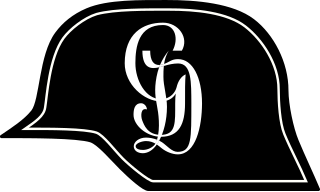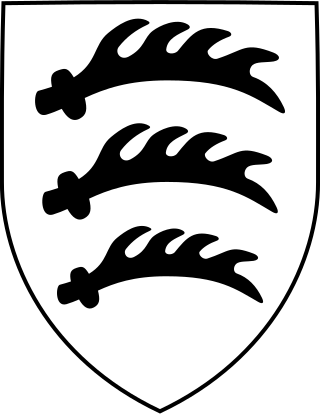
The Waffen-SS was the combat branch of the Nazi Party's paramilitary Schutzstaffel (SS) organisation. Its formations included men from Nazi Germany, along with volunteers and conscripts from both German-occupied Europe and unoccupied lands. It was disbanded in May 1945.

The Panzergrenadier Division "Großdeutschland", also commonly referred to simply as Großdeutschland or Großdeutschland Division, was an elite combat unit of the German Army that fought on the Eastern Front in World War II.

Felix Martin Julius Steiner was a German SS commander during the Nazi era. During World War II, he served in the Waffen-SS, the combat branch of the SS, and commanded several SS divisions and corps. He was awarded the Knight's Cross of the Iron Cross with Oak Leaves and Swords. Together with Paul Hausser, he contributed significantly to the development and transformation of the Waffen-SS into a combat force made up of volunteers and conscripts from both occupied and un-occupied lands.
The Fallschirm-Panzer-Division 1. Hermann Göring was a German Luftwaffe armoured division. The HG saw action in France, North Africa, Sicily, Italy and on the Eastern Front during World War II. The division began as a battalion-sized police unit in 1933. Over time it grew into a regiment, brigade, division, and finally was combined with the Parachute-Panzergrenadier Division 2 Hermann Göring on 1 May 1944 to form a Panzer corps under the name Reichsmarschall. It surrendered to the Soviet Army near Dresden on 8 May 1945.

The 2nd SS Panzer Division Das Reich or SS Division Das Reich was an armored division of the Waffen-SS of Nazi Germany during World War II.
XXXXVIII Panzer Corps, was a corps-level formation of the German Army which saw extensive action on both the Eastern and Western Fronts during World War II.

The 17th SS Panzergrenadier Division "Götz von Berlichingen" was a German Waffen-SS division that saw action on the Western Front during World War II.
The III (Germanic) SS Panzer Corps was a Waffen-SS armoured corps which saw action on the Eastern Front during World War II. The (Germanische) part of its designation was granted as it was composed primarily of foreign volunteer formations.

The Volunteer Legion Netherlands was a collaborationist military formation recruited in the German-occupied Netherlands during World War II. It was formed in the aftermath of the German invasion of the Soviet Union and fought on the Eastern Front in the Waffen SS alongside similar formations from other parts of German-occupied Western Europe. It was the largest Dutch SS unit.
Thomas Müller was a German Waffen-SS officer who commanded the SS-NCO Training School (Waffen-SS-Unterführerschule) in Radolfzell, 9th SS Panzer Division Hohenstaufen, 17th SS Panzergrenadier Division Götz von Berlichingen and the 6th SS Volunteer Sturmbrigade Langemarck during World War II. He saw action on the East and the West, finishing the war on the Oder front.
The IV SS Panzer Corps was a panzer corps of the Waffen-SS which saw action on the Eastern Front and in the Balkans during World War II.
The II SS Panzer Corps was a German Waffen-SS armoured corps which saw action on both the Eastern and Western Fronts during World War II. It was commanded by Paul Hausser during the Third Battle of Kharkov and the Battle of Kursk in 1943 and by Wilhelm Bittrich on the Western Front in 1944.

The I SS Panzer Corps was a German armoured corps of the Waffen-SS. It saw action on both the Western and Eastern Fronts during World War II.

The 17th Panzer Division was a formation of the Wehrmacht in World War II. It was formed in November 1940 from the 27th Infantry Division. It took part in Operation Barbarossa, the invasion of the Soviet Union in June 1941, and in the winter of 1941–42 participated in the Battle of Moscow. In November 1942, the division was sent to the southern sector of the Eastern Front where it participated in Operation Winter Storm, the failed attempt to relieve the surrounded troops at Stalingrad. The division was held in reserve during the Battle of Kursk in 1943, and thereafter retreated through Ukraine and Poland, before ending the war in Czechoslovakia.

Matthias Kleinheisterkamp was a German SS commander during the Nazi era. Reaching the rank of SS-Obergruppenführer, he commanded the SS Division Totenkopf, SS Division Nord, SS Division Das Reich, III SS Panzer Corps, VII SS Panzer Corps, IV SS Panzer Corps, XII SS Army Corps and the XI SS Army Corps in World War II. Kleinheisterkamp died by suicide after being captured by the Soviets.
This is the order of battle for Operation Epsom, a Second World War battle between British and German forces in Normandy, France between 26 June and 30 June 1944.

The 25th Infantry Division was a military unit of the German Wehrmacht. It was later reclassified to 25th Motorized Infantry Division, and in June 1943 to the 25th Panzergrenadier Division.
The XI SS Corps was a Waffen-SS corps created on July 24, 1944 in southern Poland on the basis of the remains of the headquarters of the defeated V Army Corps and employed on the Eastern Front in 1944-1945 during World War II.
The 153rd Grenadier Division, sometimes referred to as 153rd Infantry Division in Wehrmacht documents, was an infantry division of the German Heer during World War II. It was founded under the name Division No. 153, and also carried the names Commander of Reserve Troops III, 153rd Reserve Division, and 153rd Field Training Division. It was first deployed in August 1939, received its first redesignation in December 1939, was renamed twice more in 1942, was destroyed by forces of the Soviet Union twice and then redeployed, and was redesignated a final time in 1945.









